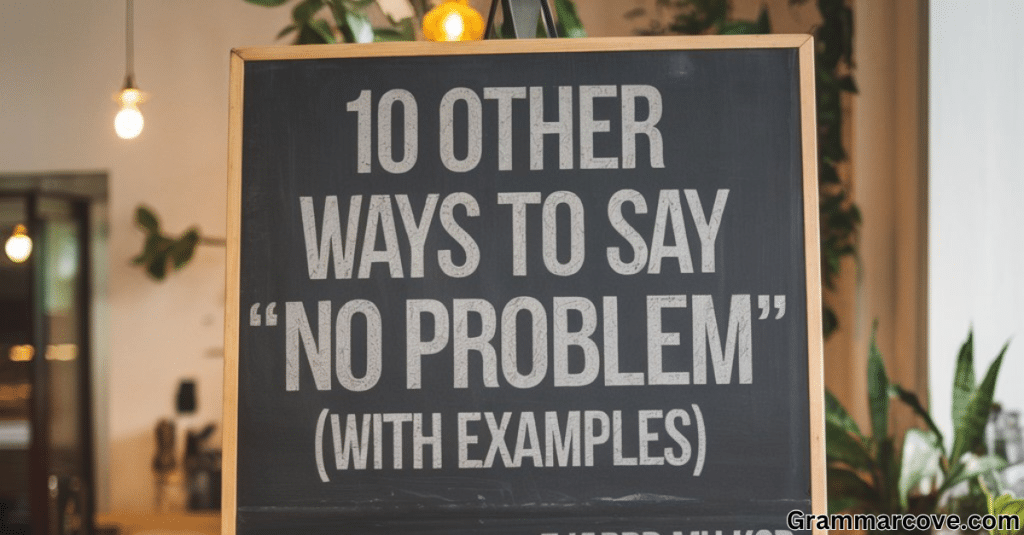In the vast world of language, the phrase “no problem” often slips effortlessly into our conversations, conveying a sense of ease and willingness to help. While this expression works well in many situations, exploring alternative expressions can elevate your communication skills, enrich your interactions, and provide a more tailored response based on context.
This article dives deep into ten different ways to express “no problem,” complete with examples and scenarios to illustrate how each phrase can fit seamlessly into various contexts.
What To Say Instead of “No Problem”
- “You’re Welcome”
- A universal, polite response suitable for any situation.
- Example: “Thank you for your help!” → “You’re welcome!”
- “Not a Problem at All”
- Reassuring and friendly, ideal for customer service.
- Example: “Thanks for fixing my account!” → “Not a problem at all!”
- “Anytime”
- Casual and friendly, perfect for informal interactions.
- Example: “Thanks for picking up the snacks!” → “Anytime!”
- “My Pleasure”
- Formal yet warm, suitable for professional contexts.
- Example: “Thank you for your guidance!” → “My pleasure!”
- “Glad to Help”
- Friendly and supportive, great for team settings.
- Example: “Thanks for your suggestions!” → “Glad to help!”
- “No Worries”
- Casual and relaxed, often used in informal settings.
- Example: “I’m so sorry for spilling!” → “No worries!”
- “Of Course!”
- Enthusiastic and eager, fitting for both casual and professional conversations.
- Example: “Thanks for your help!” → “Of course!”
- “Absolutely”
- Strong and affirmative, works well in formal and informal contexts.
- Example: “Thank you for your insights!” → “Absolutely!”
- “Sure Thing”
- Informal and friendly, suitable for relaxed interactions.
- Example: “Can you help me with my project?” → “Sure thing!”
- “It’s No Trouble”
- Humble and polite, perfect for professional responses.
- Example: “Thanks for reviewing my report!” → “It’s no trouble!”
1. “You’re Welcome”
Understanding the Phrase
The classic response of “you’re welcome” is universally recognized and appropriate in nearly all scenarios. It conveys gratitude in a straightforward manner, acknowledging the other person’s appreciation.
Scenario: Email Response
Imagine you’ve just assisted a colleague, Sarah, with a presentation. She sends you a thank-you email expressing her appreciation.
Email Example: Subject: Thank You!
Hi [Your Name],
Thank you so much for your help with the presentation! I couldn’t have done it without you.
Best,
Sarah
Your Response: Hi Sarah,
You’re welcome! I’m glad I could assist you. If you need anything else, just let me know.
This response not only acknowledges Sarah’s gratitude but also encourages future collaboration. It exemplifies polite responses and fits perfectly in both casual and professional settings.
Variations
- “You’re very welcome!”
- “Happy to help!”
2. “Not a Problem at All”
Understanding the Phrase
This phrase is an excellent way to emphasize your willingness to assist without any inconvenience. It’s reassuring and friendly, making it a solid choice in customer service and professional communication.
Scenario: Customer Service Interaction
Imagine you work in a busy customer service center, and a client named Mark expresses his gratitude for resolving an issue with his account.
Response Example: Mark: Thank you for fixing my account so quickly!
You: Not a problem at all! I’m here to help, so if you have any other questions, feel free to ask.
Using this expression demonstrates your commitment to customer satisfaction and creates a positive atmosphere, especially in customer service interactions.
Variations
- “It’s not an issue at all.”
- “I’m happy to help!”
3. “Anytime”
Understanding the Phrase
The casual expression “anytime” conveys a friendly, laid-back attitude. It works well in informal settings and helps maintain a relaxed conversation.
Scenario: Casual Conversation
You’re hanging out with your friend Alex, who thanks you for picking up groceries during a busy week.
Conversation Example: Alex: Thanks for grabbing those snacks!
You: Anytime! I’m always up for a snack run.
This response keeps the conversation light and friendly, reinforcing the bond between you and your friend.
Variations
- “Anytime you need me!”
- “I’m always here for you!”
4. “My Pleasure”
Understanding the Phrase
“My pleasure” is a formal yet warm response. It conveys a genuine sense of happiness in helping someone and works beautifully in both professional and personal contexts.
Scenario: Formal Setting
You assist a client named Julia with a project, and she expresses her gratitude in a formal email after a successful collaboration.
Email Example: Subject: Thank You for Your Support
Dear [Your Name],
Thank you for your guidance on the project. Your insights were invaluable.
Sincerely,
Julia
Your Response: Dear Julia,
My pleasure! I’m glad I could contribute. If you need further assistance, don’t hesitate to reach out.
Using “my pleasure” adds a touch of professionalism and enhances your articulate communication, making it suitable for workplace settings.
Variations
- “It’s my pleasure to help.”
- “Delighted to assist!”
5. “Glad to Help”

Understanding the Phrase
This phrase is a straightforward and friendly way to convey that you are happy to assist someone. It fosters a supportive environment and is particularly effective in collaborative settings.
Scenario: Team Collaboration
During a team meeting, your coworker Tom thanks you for your input on a marketing strategy that led to successful outcomes.
Meeting Example: Tom: I appreciate your suggestions on the marketing strategy.
You: Glad to help! I think we’re on the right track.
By using this expression, you create a supportive atmosphere among team members, emphasizing teamwork and collaboration.
Variations
- “Happy to help out!”
- “Always glad to lend a hand!”
6. “No Worries”
Understanding the Phrase
This phrase is casual and relaxed, often used in informal conversations to reassure someone that everything is fine. It’s a common expression in many English-speaking countries.
Scenario: Informal Setting
You’re at a coffee shop with your friend Jenna, who accidentally spills her drink and apologizes profusely.
Conversation Example: Jenna: I’m so sorry for spilling!
You: No worries! It happens to the best of us.
Using this phrase lightens the mood and reassures your friend that it’s perfectly okay, fostering a relaxed atmosphere in casual interactions.
Variations
- “No problem at all!”
- “It’s all good!”
7. “Of Course!”
Understanding the Phrase
This enthusiastic expression conveys your eagerness to help. It’s suitable for both professional and personal contexts, highlighting your readiness to assist.
Scenario: Quick Workplace Interaction
You assist your coworker Mike with a last-minute task he needs help with before a deadline.
Conversation Example: Mike: Thanks for helping me out on such short notice!
You: Of course! I’m always here to support the team.
This phrase underscores your commitment to teamwork and collaboration, making it a great addition to workplace communication.
Variations
- “Absolutely!”
- “Certainly!”
8. “Absolutely”
Understanding the Phrase
“Absolutely” is a strong affirmative response that conveys certainty and enthusiasm. It works well in both formal and informal settings, making it versatile.
Scenario: Formal Thank You
After presenting at a conference, an attendee named Rachel thanks you for your insights.
Response Example: Rachel: Thank you for sharing your expertise today!
You: Absolutely! I’m glad you found it helpful.
This response not only acknowledges the gratitude but also reinforces your confidence and expertise, making it a valuable expression in professional communication.
Variations
- “Definitely!”
- “For sure!”
9. “Sure Thing”
Understanding the Phrase
“Sure thing” is an informal expression that conveys eagerness and willingness to help. It’s friendly and casual, making it suitable for relaxed environments.
Scenario: Friendly Email
You receive a message from a friend named Chris asking for a favor regarding an upcoming project.
Email Example: Subject: Quick Favor
Hey [Your Name],
Can you help me with my project this weekend?
Thanks!
Chris
Your Response: Hey Chris,
Sure thing! I’d be happy to help out. Just let me know when you need me.
This phrase fits well into casual conversation, making it ideal for interactions with friends.
Variations
- “Absolutely, no problem!”
- “Count me in!”
10. “It’s No Trouble”
Understanding the Phrase
This expression conveys that assisting someone requires minimal effort on your part, making it a humble and polite response. It’s particularly effective in professional settings.
Scenario: Professional Context
A colleague named Lisa expresses gratitude for your help with a report that had a tight deadline.
Email Example: Subject: Thank You for Your Assistance
Hi [Your Name],
Thank you for reviewing my report! I really appreciate it.
Best,
Lisa
Your Response: Hi Lisa,
It’s no trouble! I’m glad I could help. Let me know if you need anything else.
Using reassuring phrases like this not only shows your willingness to assist but also maintains a friendly rapport in professional settings.
Variations
- “No trouble at all!”
- “Happy to help anytime!”
Conclusion
Incorporating these synonyms for “no problem” can greatly enhance your communication skills. By understanding the nuances of each phrase and applying them in the right context, you can foster better relationships and create a more positive atmosphere in your interactions.
Using varied language adds richness to your communication, making your responses feel more personalized and engaging. Whether you’re engaging in casual phrases with friends or maintaining professionalism in the workplace, each of these expressions offers a unique way to acknowledge someone’s gratitude.
Final Thoughts
The next time someone thanks you, consider using one of these expressions instead of falling back on the familiar “no problem.” Each phrase carries its own flavor, allowing you to tailor your response to fit the situation perfectly. This not only makes your interactions more memorable but also reinforces the importance of positive language in everyday communication.
By incorporating these varied expressions into your vocabulary, you’ll not only sound more approachable but also improve your overall communication effectiveness. Embrace the beauty of linguistic variety and elevate your conversations, whether in casual settings, professional environments, or customer service scenarios.
Practical Tips for Implementing These Phrases
- Practice in Daily Conversations: Try to integrate these phrases into your everyday interactions. The more you use them, the more natural they’ll feel.
- Tailor to Your Audience: Consider the context and the person you’re speaking to. Some phrases work better in formal settings, while others shine in casual conversations.
- Be Genuine: Choose expressions that align with your personality. Authenticity resonates well in communication, making your responses more meaningful.
- Watch for Nonverbal Cues: Pay attention to body language and tone when using these phrases. A friendly demeanor enhances the impact of your words.
- Reflect on Past Interactions: Think back to times you used “no problem.” Can you substitute one of these expressions next time? This reflection can lead to improved communication skills.
Incorporating these suggestions will help you navigate conversations with confidence, fostering positive relationships and enhancing your interactions, whether they’re casual chats with friends or professional discussions with colleagues.


